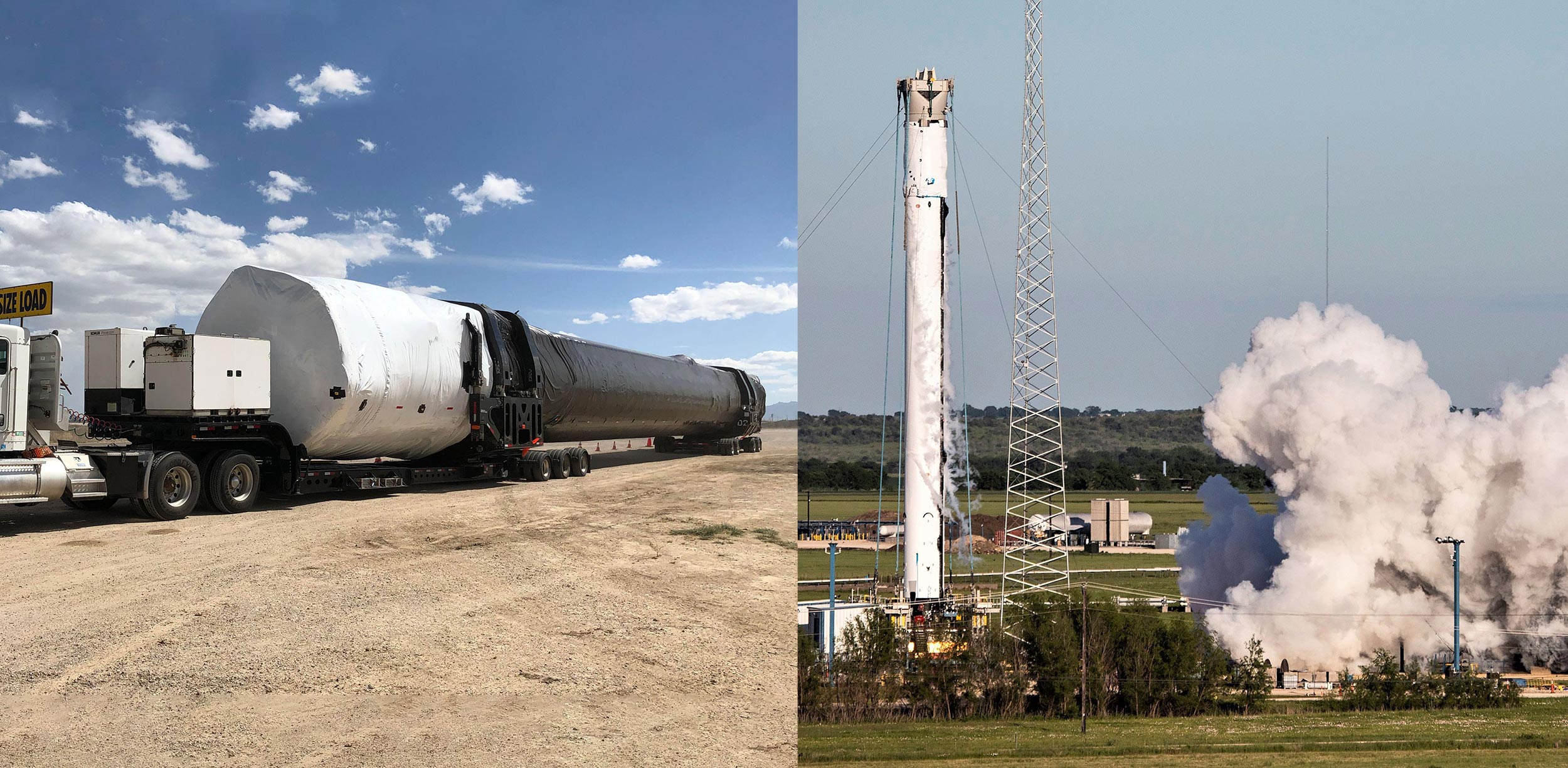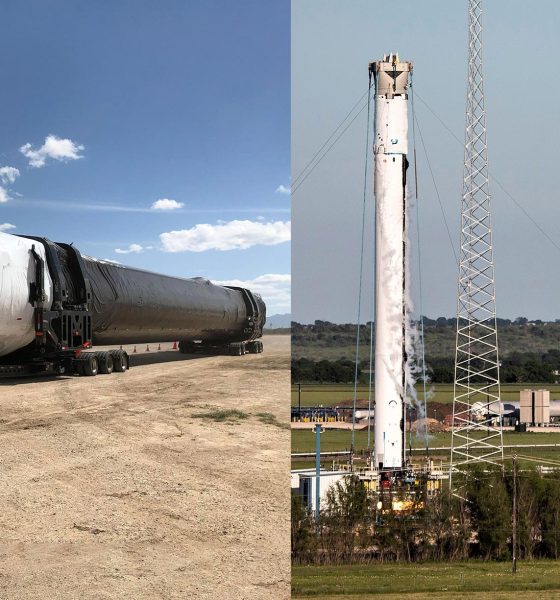

News
SpaceX’s third Falcon Heavy launch on track as custom booster aces static fire
SpaceX has successfully completed a static fire of its newest Falcon Heavy center core, a sign that the most challenging hardware is firmly on track for a late-June launch target.
Currently penciled in for June 22nd, Falcon Heavy’s third launch is of great interest to both SpaceX and its customer, the US Air Force. Most of the two-dozen payloads manifested on the mission are admittedly unaffiliated with the US military. However, the rideshare – known as Space Test Program 2 (STP-2) – was acquired by the USAF for the branch to closely evaluate and certify SpaceX’s Falcon Heavy rocket for critical military launches. The potential upsides of a successful demonstration and evaluation are numerous for both entities and would likely trigger additional positive offshoots.
The Center Core experience
Beyond the general contractual aspects of STP-2, the mission is significant because it will use the third Falcon Heavy center core and second Block 5 variant to be built and launched by SpaceX. Of the technical issues that complicated and delayed SpaceX’s Falcon Heavy development, most can probably be traced back to the rocket’s center core, practically a clean-slate redesign relative to a ‘normal’ Falcon 9 booster.
Most of that work centered around the extreme mechanical loads the center core would have to survive when pulling or being pulled by Falcon Heavy’s two side boosters. Not only would the center core have to survive at least two times as much stress as a Falcon 9 booster, but that stress would be exerted in ways that Falcon 9 boosters simply weren’t meant to experience, let alone survive. After years of work, SpaceX arrived at a design that dumped almost all of that added complexity squarely on the center core and the center core alone. The side boosters would need to use nosecones instead of interstages and have custom attachment points installed on their octawebs and noses, but they would otherwise be unmodified Falcon 9 boosters.


On top of that, SpaceX’s Falcon upper stage and payload fairing would require no major modifications to support Falcon Heavy missions. On the opposite hand, the center core would require extensive rework to safely survive the trials of launch, let alone do so in a fashion compatible with booster recovery and reuse. Per the landing photos above, it’s difficult to tell a Falcon Heavy center core apart from a normal Falcon 9 booster, but the small visible changes are just the tips of several icebergs. Aside from a slight indication that the center core’s aluminum alloy tank walls are significantly thicker (they are), center cores feature a variety of unique mechanisms on their octawebs and interstages. All are involved in the tasks of locking all three boosters together, transferring side booster thrust to the center core, and mechanically separating the side boosters from the center core a few minutes after launch.
Underneath those mechanistic protuberances are the structural optimizations needed for a center core to survive the ordeal of launch. In short, to solve for those new loads, SpaceX wound up building a new rocket. Designing and building a new rocket – especially one as complex as Falcon Heavy’s center core – is immensely challenging, expensive, and time-consuming, particularly for the first few built. Like most complex products, building the first two Falcon Heavy center cores was probably no different. To make things worse, boosters 1 and 2 were based on totally different versions of Falcon 9 (Block 3 vs. Block 5), requiring even more work to further redesign and requalify the modified rocket.

This is where the center core assigned to Falcon Heavy Flight 3 and pictured above comes into play. Built just a few months apart from B1055, the first finished Falcon Heavy Block 5 center core, the newest center core – likely B1057 – is also the first to be built with the same design and manufacturing processes used on its predecessor. In other words, SpaceX can at long last begin serial production of Falcon Heavy center cores, allowing its engineering, production, test, and launch staff to finally get far more accustomed to the unique hardware.
Given Falcon Heavy’s healthy and growing manifest of 5-6 launches, SpaceX will probably need to build several additional Block 5 center cores over the next several years, hopefully resulting in a more refined flow for production, testing, and refurbishment. B1057 will be an excellent candidate for the first reused Falcon Heavy center core thanks to STP-2’s lightweight nature and an extremely gentle landing trajectory. With respect to Flight 3’s schedule, Crew Dragon’s April 20th explosion means that Falcon Heavy will have Pad 39A all to itself for many months to come. Truly the epitome of bittersweet, no doubt, but it does improve the odds that Falcon Heavy’s June 22nd STP-2 launch target will hold.
Check out Teslarati’s Marketplace! We offer Tesla accessories, including for the Tesla Cybertruck and Tesla Model 3.

News
Nvidia CEO Jensen Huang explains difference between Tesla FSD and Alpamayo
“Tesla’s FSD stack is completely world-class,” the Nvidia CEO said.

NVIDIA CEO Jensen Huang has offered high praise for Tesla’s Full Self-Driving (FSD) system during a Q&A at CES 2026, calling it “world-class” and “state-of-the-art” in design, training, and performance.
More importantly, he also shared some insights about the key differences between FSD and Nvidia’s recently announced Alpamayo system.
Jensen Huang’s praise for Tesla FSD
Nvidia made headlines at CES following its announcement of Alpamayo, which uses artificial intelligence to accelerate the development of autonomous driving solutions. Due to its focus on AI, many started speculating that Alpamayo would be a direct rival to FSD. This was somewhat addressed by Elon Musk, who predicted that “they will find that it’s easy to get to 99% and then super hard to solve the long tail of the distribution.”
During his Q&A, Nvidia CEO Jensen Huang was asked about the difference between FSD and Alpamayo. His response was extensive:
“Tesla’s FSD stack is completely world-class. They’ve been working on it for quite some time. It’s world-class not only in the number of miles it’s accumulated, but in the way it’s designed, the way they do training, data collection, curation, synthetic data generation, and all of their simulation technologies.
“Of course, the latest generation is end-to-end Full Self-Driving—meaning it’s one large model trained end to end. And so… Elon’s AD system is, in every way, 100% state-of-the-art. I’m really quite impressed by the technology. I have it, and I drive it in our house, and it works incredibly well,” the Nvidia CEO said.
Nvidia’s platform approach vs Tesla’s integration
Huang also stated that Nvidia’s Alpamayo system was built around a fundamentally different philosophy from Tesla’s. Rather than developing self-driving cars itself, Nvidia supplies the full autonomous technology stack for other companies to use.
“Nvidia doesn’t build self-driving cars. We build the full stack so others can,” Huang said, explaining that Nvidia provides separate systems for training, simulation, and in-vehicle computing, all supported by shared software.
He added that customers can adopt as much or as little of the platform as they need, noting that Nvidia works across the industry, including with Tesla on training systems and companies like Waymo, XPeng, and Nuro on vehicle computing.
“So our system is really quite pervasive because we’re a technology platform provider. That’s the primary difference. There’s no question in our mind that, of the billion cars on the road today, in another 10 years’ time, hundreds of millions of them will have great autonomous capability. This is likely one of the largest, fastest-growing technology industries over the next decade.”
He also emphasized Nvidia’s open approach, saying the company open-sources its models and helps partners train their own systems. “We’re not a self-driving car company. We’re enabling the autonomous industry,” Huang said.
Elon Musk
Elon Musk confirms xAI’s purchase of five 380 MW natural gas turbines
The deal, which was confirmed by Musk on X, highlights xAI’s effort to aggressively scale its operations.

xAI, Elon Musk’s artificial intelligence startup, has purchased five additional 380 MW natural gas turbines from South Korea’s Doosan Enerbility to power its growing supercomputer clusters.
The deal, which was confirmed by Musk on X, highlights xAI’s effort to aggressively scale its operations.
xAI’s turbine deal details
News of xAI’s new turbines was shared on social media platform X, with user @SemiAnalysis_ stating that the turbines were produced by South Korea’s Doosan Enerbility. As noted in an Asian Business Daily report, Doosan Enerbility announced last October that it signed a contract to supply two 380 MW gas turbines for a major U.S. tech company. Doosan later noted in December that it secured an order for three more 380 MW gas turbines.
As per the X user, the gas turbines would power an additional 600,000+ GB200 NVL72 equivalent size cluster. This should make xAI’s facilities among the largest in the world. In a reply, Elon Musk confirmed that xAI did purchase the turbines. “True,” Musk wrote in a post on X.
xAI’s ambitions
Recent reports have indicated that xAI closed an upsized $20 billion Series E funding round, exceeding the initial $15 billion target to fuel rapid infrastructure scaling and AI product development. The funding, as per the AI startup, “will accelerate our world-leading infrastructure buildout, enable the rapid development and deployment of transformative AI products.”
The company also teased the rollout of its upcoming frontier AI model. “Looking ahead, Grok 5 is currently in training, and we are focused on launching innovative new consumer and enterprise products that harness the power of Grok, Colossus, and 𝕏 to transform how we live, work, and play,” xAI wrote in a post on its website.
Elon Musk
Elon Musk’s xAI closes upsized $20B Series E funding round
xAI announced the investment round in a post on its official website.

xAI has closed an upsized $20 billion Series E funding round, exceeding the initial $15 billion target to fuel rapid infrastructure scaling and AI product development.
xAI announced the investment round in a post on its official website.
A $20 billion Series E round
As noted by the artificial intelligence startup in its post, the Series E funding round attracted a diverse group of investors, including Valor Equity Partners, Stepstone Group, Fidelity Management & Research Company, Qatar Investment Authority, MGX, and Baron Capital Group, among others.
Strategic partners NVIDIA and Cisco Investments also continued support for building the world’s largest GPU clusters.
As xAI stated, “This financing will accelerate our world-leading infrastructure buildout, enable the rapid development and deployment of transformative AI products reaching billions of users, and fuel groundbreaking research advancing xAI’s core mission: Understanding the Universe.”
xAI’s core mission
Th Series E funding builds on xAI’s previous rounds, powering Grok advancements and massive compute expansions like the Memphis supercluster. The upsized demand reflects growing recognition of xAI’s potential in frontier AI.
xAI also highlighted several of its breakthroughs in 2025, from the buildout of Colossus I and II, which ended with over 1 million H100 GPU equivalents, and the rollout of the Grok 4 Series, Grok Voice, and Grok Imagine, among others. The company also confirmed that work is already underway to train the flagship large language model’s next iteration, Grok 5.
“Looking ahead, Grok 5 is currently in training, and we are focused on launching innovative new consumer and enterprise products that harness the power of Grok, Colossus, and 𝕏 to transform how we live, work, and play,” xAI wrote.








